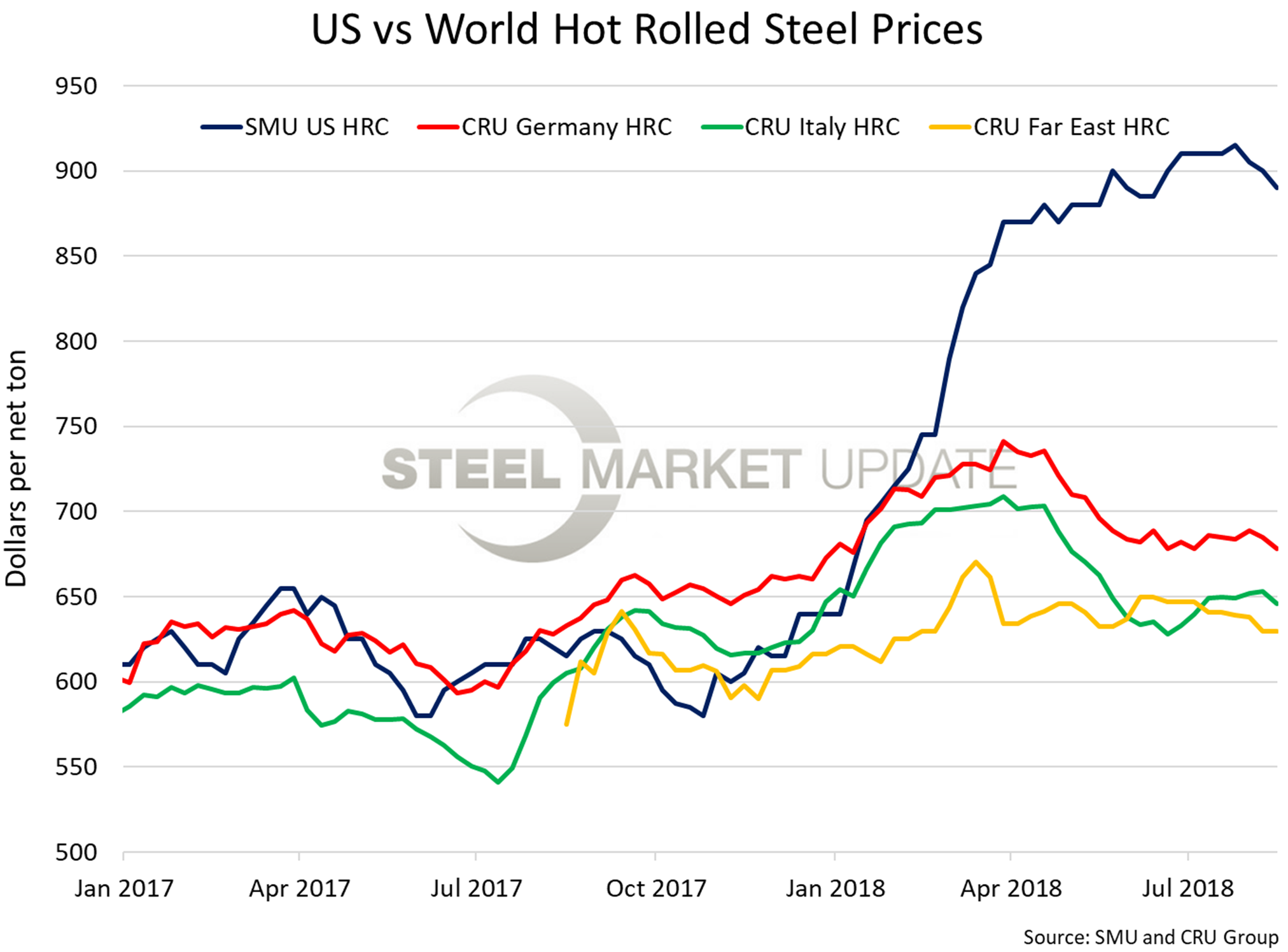International Steel Prices

Foreign vs. Domestic HRC: High Price Spread Slightly Eases
Written by Brett Linton
August 20, 2018
The following calculation is used by Steel Market Update to identify the theoretical spread between foreign hot rolled steel import prices (delivered to USA ports) and domestic hot rolled coil prices (FOB domestic mills). We want our readers to be aware that this is only a “theoretical” calculation as freight costs, trader margin and other costs can fluctuate, ultimately influencing the true market spread. We do not include the 25 percent tariff or any other unusual costs to the calculations we provide.
We are now comparing the SMU U.S. hot rolled weekly index to CRU weekly price indices for Germany, Italy and the Far East (East and Southeast Asian port). We also periodically include CRU monthly price indices for Turkey, CIS and Brazil when they are updated.
![]() SMU adds $90 per ton to these foreign prices taking into consideration freight costs, handling, trader margin, etc. This provides an approximate “CIF U.S. ports price” that can then be compared against the SMU U.S. hot rolled price, with the result being the spread (difference) between domestic and foreign hot rolled prices. As the price spread narrows, the competitiveness of imported steel into the United States is reduced. If the spread widens, then foreign steel becomes more attractive to U.S. flat rolled steel buyers. A positive spread means U.S. prices are higher than foreign prices, while a negative spread means U.S. prices are less than foreign prices.
SMU adds $90 per ton to these foreign prices taking into consideration freight costs, handling, trader margin, etc. This provides an approximate “CIF U.S. ports price” that can then be compared against the SMU U.S. hot rolled price, with the result being the spread (difference) between domestic and foreign hot rolled prices. As the price spread narrows, the competitiveness of imported steel into the United States is reduced. If the spread widens, then foreign steel becomes more attractive to U.S. flat rolled steel buyers. A positive spread means U.S. prices are higher than foreign prices, while a negative spread means U.S. prices are less than foreign prices.
As of Wednesday, Aug. 15, the CRU German HRC price was $588 per net ton, down $7 from the previous week. Adding $90 per ton for import costs, that puts the price at $678 per ton from Germany delivered to the U.S. The latest Steel Market Update hot rolled price average is $890 per ton for domestic steel, down $10 over last week. The spread between German and U.S. HR prices is now +$212 per ton, down from +$215 last week, and down from +$216 two weeks ago. That means domestic HR is now theoretically $212 per ton more expensive than importing HR steel from Germany. This is the third consecutive weekly decline, down $19 total. The four-week average price spread is now +$219 per ton, down $3 from last week.
CRU published Italian HRC prices down $7 over last week to $556 per net ton. After adding import costs, we get a delivered price of approximately $646 per ton. The spread between the Italy and U.S. figure is +$244 per ton, down from +$247 one week ago and +$253 two weeks ago. Meaning that U.S. HR is theoretically $244 per ton more expensive than importing steel from Italy. This is the third consecutive weekly decline, down $22 total. The four-week average is now +$253, down $4 over last week.
The CRU Far East HRC price remained steady at $540 per net ton. Adding import costs, that puts the price at $630 per ton. The spread between the Far East and U.S. figure is +$260 per ton, down from +$270 last week and down from +$267 from two weeks ago. That means domestic HR would theoretically be $260 per ton more expensive than importing steel from East or Southeast Asia. The four-week average price spread is now +$268 per ton, down $3 from last week.
On a monthly basis, CRU publishes hot rolled export prices for Turkey, CIS and Brazil. Through Aug. 8, the Turkey export price was $553 per ton, up $9 from the previous month. After import costs, the spread between Turkey and the U.S. price is +$257 per ton, down $19 from one month ago. The August CIS export price was $517 per ton, unchanged from last month. After import costs, the spread between the CIS and U.S. price is +$293 per ton, down $10 over one month ago. The latest Brazil export price was $572 per ton, unchanged over mid-July. After import costs, the spread between the Brazil and U.S. price is +$238 per ton, down $10 from last month.
Freight is an important part of the final determination on whether to import foreign steel or buy from a domestic mill supplier. Domestic prices are referenced as FOB the producing mill, while foreign prices are FOB the Port (Houston, NOLA, Savannah, Los Angeles, Camden, etc.). Inland freight, from either a domestic mill or from the port, can dramatically impact the competitiveness of both domestic and foreign steel. When considering lead times, a buyer must take into consideration the momentum of pricing both domestically and in the world markets. In most circumstances (but not all), domestic steel will deliver faster than foreign steel ordered on the same day.
The graphic below shows all four weekly price indices above. We plan to turn this into an interactive graphic and add a webpage in the “Steel Prices” section of our website soon.


Brett Linton
Read more from Brett LintonLatest in International Steel Prices

US and offshore HRC prices tick lower
The threat of tariffs over the past two months has been a springboard for US prices. But the Section 232 reinstatement on March 13 narrowed the domestic premium over imports on a landed basis.

Domestic CRC prices surge ahead of imports
The price spread between stateside-produced CR and imports reached its widest margin in over a year.

US HR prices rising faster than offshore tags
Hot-rolled (HR) coil prices continued to rally in the US this week, quickly outpacing price gains seen abroad. The result: US hot band prices have grown widely more expensive than imports on a landed basis. The premium US HR tags carry over HR prices abroad now stands at a 14-month high. SMU’s average domestic HR […]

US HR price premium over imports widens
Hot-rolled (HR) coil prices were flat in the US this week, while tags in offshore markets were mostly down.

US HR price premium over imports edges up
The price premium between stateside hot band and landed imports widened slightly this week.
